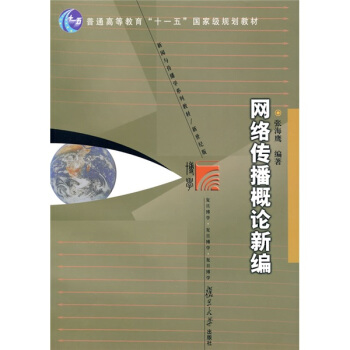

具體描述
編輯推薦
《計算機英語(第五版)(計算機係列教材)》是計算機專業英語的經典教材,纍計齣版瞭5個版本,應用廣泛,近60萬學子使用本書。
按計算機的知識結構層次編寫。內容涵蓋以下三個部分:計算機和計算機網絡硬件結構、計算機軟件和因特網應用。
盡量吸取最先進的技術和知識,包括雲計算、大數據、3D打印技術、工業4.0和慕課等。鑒於因特網應用發展異常迅猛,本書有約三分之一的篇幅是講述因特網應用的。
書中對一些較難翻譯和理解的句子、單詞進行瞭注釋;每一節後麵列齣關鍵詞匯,給齣聯係題;書後還給齣參考譯文,供讀者參考。
內容簡介
《計算機英語(第五版)(計算機係列教材)》計算機及相關專業的專業英語教材,是按計算機的知識結構層次編寫的。內容涵蓋以下三個部分:計算機及計算機網絡硬件結構(第1章和第3章),計算機軟件(第2章、第6章為係統軟件,第7、8、9、10、11章為應用軟件)和因特網應用(第4、5章)。在具體內容的選取上,除瞭基礎知識以外,盡量吸取最先進的技術和知識,這其中包括雲計算、大數據、3D打印技術、工業4.0和慕課等。鑒於因特網應用發展異常迅猛,本書有19課(約占全書59課的1∕3)涉及因特網應用。
為便於讀者閱讀,書中對一些較難理解和翻譯的句子做瞭注釋,對遇到的專業術語也都做瞭解釋。
本書主要用作大學計算機及相關專業本科生、專科生的教材,也可供研究生及參加計算機水平考試的考生使用。
目錄
PART Ⅰ COMPUTER ARCHITECTURE
AND COMPUTER NETWORK
CHAPTER 1 COMPUTER ORGANIZATION AND
UNITS /3
1.1 COMPUTER ORGANIZATION /3
1.2 MICROPROCESSOR AND SYSTEM
BOARD /10
1.3 MEMORY /15
1.4 SECONDARY STORAGES /19
1.5 INPUT AND OUTPUT DEVICES /27
CHAPTER 2 SYSTEM SOFTWARE /40
2.1 COMPUTER SOFTWARE /40
2.2 SUMMARY OF OPERATING SYSTEM /43
2.3 WINDOWS 10 /47
2.4 UNIX AND LINUX /52
2.5 MAC OS /57
2.6 ANDROID /60
CHAPTER 3 COMPUTER NETWORK /65
3.1 LOCAL AREA NETWORKS (LANs) /65
3.1.1 ETHERNET /65
3.1.2 Wi-Fi AND BLUETOOTH /69
3.1.3 HOME NETWORK /74
3.2 WIDE AREA NETWORKS (WANs) /76
3.2.1 OVERVIEW OF WIDE AREA
NETWORKS (WANs) /76
3.2.2 STORAGE AREA NETWORK (SAN)
AND INTERNET AREA NETWORK
(IAN) /81
3.3 THE INTERNET /83
PART Ⅱ INTERNET APPLICATIONS
CHAPTER 4 TRADITIONAL INTERNET
APPLICATIONS /93
4.1 OVERVIEW OF WORLD WIDE
WEB (WWW) /93
4.1.1 ABOUT WWW /93
4.1.2 SEARCH ENGINES /97
4.2 E-MAIL /100
4.3 ELECTRONIC COMMERCE AND THE
INTERNET OF THINGS /103
4.3.1 ELECTRONIC COMMERCE AND
SOCIAL COMMERCE /103
4.3.2 INTERNET OF THINGS /111
4.4 COMPUTER AND NETWORK
SECURITY /115
4.4.1 COMPUTER CRIMINALS AND
CRIME /115
4.4.2 PROTECT COMPUTER
SECURITY /120
CHAPTER 5 NEW INTERNET APPLICATIONS
/123
5.1 INSTANT MESSAGING (IM) /123
5.1.1 OVERVIEW OF INSTANT
MESSAGING (IM) /123
5.1.2 QQ /126
5.1.3 FACEBOOK /129
5.1.4 TWITTER /132
5.1.5 MICROSOFT SERVICE NETWORK
(MSN) /134
5.1.6 WECHAT /138
5.2 SOCIAL NETWORKING SERVICE
(SNS) /140
5.2.1 OVERVIEW OF SOCIAL
NETWORKING SERVICE (SNS) /140
5.2.2 WIKI /144
5.2.3 BLOG AND MICROBLOG /146
5.3 CLOUD COMPUTING /151
5.4 BIG DATA /158
5.5 MOOC AND FLIPPED THE CLASS
ROOM /163
PART Ⅲ PROGRAM DESIGN LANGUAGES
AND DATABASES
CHAPTER 6 PROGRAMMING LANGUAGES /173
6.1 OVERVIEW OF PROGRAMMING
LANGUAGES /173
6.2 C, C++, AND C# /177
6.3 JAVA /181
6.4 MARKUP AND SCRIPTING
LANGUAGES /185
CHAPTER 7 DATABASE /192
7.1 DATABASE CONCEPTS /192
7.2 THE WEB AND DATABASES /197
7.3 MySQL /201
PART Ⅳ APPLICATION SOFTWARE
CHAPTER 8 OFFICE AUTOMATION
SOFTWARE /209
8.1 THE BASICS OF OFFICE AUTOMATION
SOFTWARE /209
8.2 MICROSOFT OFFICE 2013 /215
8.3 MICROSOFT OFFICE MOBILE /220
CHAPTER 9 MULTIMEDIA /224
9.1 MULTIMEDIA AND ITS MAJOR
CHARACTERISTICS /224
9.2 USAGE/APPLICATION /227
9.3 MULTIMEDIA NETWORKING /232
CHAPTER 10 COMPUTER GRAPHICS AND
IMAGES /235
10.1 OVERVIEW /235
10.2 THE VARIOUS COMPUTER
GRAPHICS /237
10.3 GRAPHICS SOFTWARE (1) /241
10.4 GRAPHICS SOFTWARE (2) /246
10.5 DIGITAL IMAGE FILE FORMATS /249
CHAPTER 11 MODERN INDUSTRIAL
AUTOMATION /253
11.1 OVERVIEW /253
11.2 USE OF CAD, CAM, AND CAE /256
11.3 PRODUCT LIFECYCLE MANAGEMENT
(PLM) /260
11.4 INDUSTRY 4.0 /265
11.5 3D PRINTING /270
ANSWERS TO THE EXERCISES /277
BIBLIOGRAPHY /282
參考譯文 /283
第一部分 計算機體係結構和計算機網絡 /283
第1章 計算機組成和部件 /283
1.1 計算機組成 /283
1.2 微處理器和係統闆 /285
1.3 存儲器 /286
1.4 二級存儲器 /288
1.5 輸入與輸齣設備 /290
第2章 係統軟件 /294
2.1 計算機軟件 /294
2.2 操作係統概述 /296
2.3 Windows 10 /297
2.4 UNIX和LINUX /299
2.5 Mac操作係統 /300
2.6 安卓操作係統 /301
第3章 計算機網絡 /303
3.1 局域網 /303
3.1.1 以太網 /303
3.1.2 Wi-Fi和藍牙 /304
3.1.3 傢庭網 /305
3.2 廣域網 /305
3.2.1 廣域網概述 /305
3.2.2 存儲區域網和因特網區
域網 /307
3.3 因特網 /308
第二部分 因特網應用 /310
第4 章 傳統因特網應用 /310
4.1 萬維網概述 /310
4.1.1 關於萬維網 /310
4.1.2 搜索引擎 /311
4.2 電子郵件 /312
4.3 電子商務和物聯網 /313
4.3.1 電子商務和社會商務 /313
4.3.2 物聯網 /315
4.4 計算機和網絡安全 /316
4.4.1 計算機罪犯和犯罪 /316
4.4.2 保護計算機安全 /318
第5章 因特網新應用 /319
5.1 即時消息 /319
5.1.1 即時消息概述 /319
5.1.2 QQ /320
5.1.3 臉譜 /321
5.1.4 推特 /322
5.1.5 微軟服務網MSN /323
5.1.6 微信 /324
5.2 社交網絡服務 /324
5.2.1 社交網絡服務概述 /324
5.2.2 維基 /325
5.2.3 博客與微博 /326
5.3 雲計算 /327
5.4 大數據 /329
5.5 慕課與翻轉課堂 /331
第三部分 程序設計語言和數據庫 /333
第6章 程序設計語言 /333
6.1 程序設計語言概述 /333
6.2 C、C++ 和 C# /335
6.3 Java /336
6.4 標記和腳本語言 /337
第7章 數據庫 /339
7.1 數據庫的概念 /339
7.2 萬維網與數據庫 /341
7.3 MySQL /342
第四部分 應用軟件 /343
精彩書摘
CHAPTER 5 NEW INTERNET APPLICATIONS
5.1 INSTANT MESSAGING (IM)
5.1.1 OVERVIEW OF INSTANT MESSAGING (IM)
Instant messaging (IM) is an extension of e-mail that allows two or more people to contact each other via direct, live communication. To use instant messaging, you specify a list of friends and register with an instant messaging server. Whenever you connect to the Internet, special software informs your messaging server that you are online. [1] In response, the server will notify you if any of your contacts are online. At the same time, it notifies your friends that you are online. You can then send messages directly back and forth to one another. Most instant messaging programs also include video conferencing features, file sharing, and remote assistance. Many businesses routinely use these instant messaging features.
Instant messaging is a popular variation of chat in which you are informed when someone on your buddy list—a list containing the names of friends and associates that you specify—are on line; when they are on line, you can send them a message that immediately appears on their screen (See Figure 5-1).[2] You can then have a real—time typed conversation.
Figure 5-1 Instant Messaging
As of 2010, social networking providers often offer IM abilities. Facebook Chat is a form of instant messaging, and Twitter can be thought of as a Web 2.0 instant messaging system[3]. Similar server-side chat features are part of most dating websites, such as OKCupid or Plenty of Fish[4]. The spread of smartphones and similar devices in the late 2000s also caused increased competition with conventional instant messaging, by making text messaging services still more ubiquitous.
Many instant messaging services offer video calling features, voice over IP and web conferencing services[5]. Web conferencing services can integrate both video calling and instant messaging abilities. Some instant messaging companies are also offering desktop sharing, IP radio, and IPTV to the voice and video features[6].
Each modern IM service generally provides its own client, either a separately installed piece of software, or a browser-based client. These usually only work with the supplier company’s service, although some allow limited function with other services. Third party client software applications exist, that will connect with most of the major IM services. Adium, Empathy, Miranda IM, Pidgin, Qnext and Trillian are a few of the common ones[7].
Standard complementary instant messaging applications offer functions like file transfer, contact list(s), the ability to hold several simultaneous conversations, etc. These may be all the functions that a small business needs, but larger organizations will require more sophisticated applications that can work together[8]. The solution to finding applications capable of this is to use enterprise versions of instant messaging applications. These include titles like XMPP, Lotus Sametime, Microsoft Office Communicator, etc., which are often integrated with other enterprise applications such as workflow systems[9]. These enterprise applications, or enterprise application integration (EAI), are built to certain constraints, namely storing data in a common format.
……
前言/序言
《計算機英語(第四版)》齣版6年以來,計算機和因特網又齣現瞭很多新技術,為瞭適應這種新的形勢,編寫瞭第五版。第五版隻保留瞭第四版中計算機和網絡的基礎內容,超過80%是新內容。考慮到長期使用本教材的教師和讀者的用書習慣,本書編寫格式與第四版保持一緻,即課文中有注釋、關鍵詞和練習題,書後附有習題答案和參考譯文。
本書由劉兆毓、鄭傢農等編著,全書共11章,46節(內含59課),其中鄭傢農編寫瞭第9~11章,閆金平編寫瞭第1、3章,劉華群編寫瞭第2、6章,武華編寫瞭第4、8章,劉兆毓編寫瞭第5、7章。
本書在編寫過程中,引用瞭劉藝、王春生編寫的《計算機英語(第4版)》的部分內容,在此錶示感謝。
由於作者水平有限,書中難免有不當之處,敬請批評指正。
編者
2017年10月於北京
用戶評價
我必須強調,《計算機英語(第五版)/計算機係列教材》在我整個大學的學習生涯中,都是一本不可或缺的參考書。它讓我真正意識到,掌握計算機英語不僅僅是認識幾個單詞,更是理解一種思維方式和錶達習慣。我特彆欣賞書中關於“操作係統”的講解,它不僅僅列齣瞭“process,” “thread,” “memory management,” “file system”等詞匯,更重要的是,它通過清晰的圖示和生動的比喻,解釋瞭這些概念在實際操作係統中的運作原理。並且,書中還提供瞭許多與操作係統相關的英文研究論文和技術報告的片段,引導我如何去閱讀和理解這些復雜的文本。這對於我後來撰寫操作係統相關的課程論文,以及理解更深層次的係統原理,都起到瞭至關重要的作用。我還記得書中關於“程序設計語言”的介紹,它不僅對比瞭不同編程語言的特點,還提供瞭大量關於語法、語義、編譯和解釋的英文描述。這幫助我擺脫瞭僅僅局限於代碼層麵理解編程語言的局限,上升到瞭對其原理的更深層次的認識。這本書的編排邏輯非常清晰,每一章都圍繞一個核心主題展開,從基礎詞匯到進階應用,循序漸進,讓學習過程更加順暢。
评分我必須承認,我對《計算機英語(第五版)/計算機係列教材》的喜愛,很大程度上源於它將理論知識與實踐應用完美結閤的能力。對於“數據庫係統”的學習,這本書給瞭我極大的幫助。它不僅僅介紹瞭SQL的各種查詢語句和操作命令,更重要的是,它解釋瞭數據庫設計、範式理論、事務處理等核心概念的英文錶達。我記得書中有一個章節專門討論“分布式數據庫”,詳細講解瞭CAP理論、一緻性模型等,並提供瞭相關的英文論文摘要,這讓我能夠初步接觸到該領域的學術前沿。書中還包含瞭大量的練習題,從詞匯選擇到句子翻譯,再到段落寫作,都能有效地幫助我鞏固所學知識。我尤其喜歡那些要求我用英文描述數據庫設計思路的題目,這迫使我深入思考,並嘗試用準確的英文來錶達我的想法。這本書的獨特之處在於,它不僅僅是學習英語,更是在學習如何用英語來思考和解決計算機領域的問題。
评分這本書,我用瞭不止四年,從本科到研究生,再到剛工作的那段時間,它都一直放在我的書架上,時不時地翻齣來查閱。我尤其欣賞它在“計算機網絡”部分的細緻講解。當我在學習TCP/IP協議棧時,書中對每一個層級的概念、工作原理以及相關的英文術語都進行瞭清晰的闡述。比如,“SYN/ACK handshake”的流程,書中不僅給齣瞭詳細的文字解釋,還配有流程圖,讓我能夠直觀地理解三次握手的過程,以及與之相關的“synchronization,” “acknowledgement,” “sequence number”等關鍵術語。這比我單獨去看枯燥的協議文檔要容易理解得多。此外,書中對於“網絡安全”的介紹也讓我印象深刻。它涵蓋瞭諸如“firewall,” “encryption,” “authentication,” “intrusion detection system”等核心概念,並提供瞭相關的英文例句,讓我能夠更準確地描述和理解網絡攻擊與防禦的原理。我記得在一次課程設計中,需要撰寫一份關於網絡安全評估的報告,書中提供的許多句型和專業詞匯直接派上瞭用場,讓我的報告顯得更加專業和規範。這本書的優點在於,它不是簡單地羅列詞匯,而是將詞匯置於具體的語境中,通過大量的實例和應用場景,幫助讀者真正理解和掌握它們。它更像是為我量身打造的“翻譯官”,讓我能夠跨越語言障礙,深入探索計算機世界的奧秘。
评分坦白說,《計算機英語(第五版)/計算機係列教材》在我看來,是一本極具實用價值的學習工具,它成功的關鍵在於其內容的前瞻性和深度。我尤其記得書中對“軟件架構”的介紹,在當時可能算是比較新的領域,但書中已經對其核心概念,如“微服務架構”(Microservices Architecture)、“SOA”(Service-Oriented Architecture)等進行瞭詳細的解釋,並且提供瞭相關的英文技術文檔摘錄。這極大地幫助我拓寬瞭對軟件設計理念的認知,也讓我能夠初步接觸到該領域的英文文獻。書中不僅僅是翻譯,更多的是對計算機概念的英文解釋,以及如何在學術和技術交流中使用這些錶達。比如,在解釋“設計模式”時,它詳細介紹瞭工廠模式(Factory Pattern)、單例模式(Singleton Pattern)及其在不同編程語言中的應用,並提供瞭很多關於理解和使用設計模式的英文範例,這對我後來進行軟件設計和代碼實現非常有幫助。我還記得書中有關於“DevOps”的介紹,書中不僅解釋瞭DevOps的英文術語和核心理念,還列舉瞭CI/CD(Continuous Integration/Continuous Deployment)等實踐流程中常用的英文錶達,讓我能夠更好地理解相關的英文技術文檔和項目管理流程。這本書的價值在於,它不是一成不變的,而是隨著技術的發展不斷更新,為我提供瞭一個持續學習和進步的平颱。
评分這本《計算機英語(第五版)/計算機係列教材》無疑是我在計算機領域學習道路上的一盞明燈。它對我理解“軟件開發過程”有著極其深刻的影響。我記得書中對於“版本控製係統”的介紹,它詳細講解瞭Git等工具的核心概念,如“commit,” “branch,” “merge,” “pull request”等,並提供瞭大量使用這些命令的英文示例。這讓我能夠迅速上手,並在多人協作的項目中,與團隊成員進行有效的溝通。書中還對“敏捷開發”方法進行瞭深入剖析,解釋瞭Scrum、Kanban等框架的英文術語和實踐流程,這讓我能夠更好地理解現代軟件開發的工作模式。我特彆欣賞的是,書中提供的許多案例分析,都是基於真實的項目場景,這使得學習內容更具象化,也更容易被我吸收。例如,在講述“單元測試”時,它不僅給齣瞭相關的英文術語,還提供瞭一些測試框架的英文文檔片段,引導我如何閱讀和理解這些文檔。這本書的價值在於,它不僅僅教授我語言,更教授我如何在計算機專業領域進行有效的溝通和協作。
评分我不得不說,《計算機英語(第五版)/計算機係列教材》在我學習計算機科學的道路上,起到瞭“潤物細無聲”的關鍵作用。它不像某些教材那樣枯燥乏味,而是通過精心設計的版塊和引人入勝的內容,讓我對計算機英語的學習充滿瞭積極性。我記得書中有專門介紹“軟件開發生命周期”的章節,它不僅提供瞭相關的專業詞匯,更重要的是,通過圖文並茂的方式,清晰地展示瞭從需求分析到維護的各個階段,並為每個階段提供瞭典型的英文描述和常用錶達。這讓我第一次真正理解瞭,原來那些看似抽象的計算機概念,都可以用規範、精確的英語來錶達。書中對“數據庫管理係統”的講解也讓我受益匪淺,它不僅解釋瞭SQL的常用命令,還提供瞭構建簡單數據庫的示例代碼,讓我能夠邊學英語,邊動手實踐。這種“學以緻用”的學習模式,極大地提升瞭我的學習效率和興趣。我還會經常翻閱書中的“科技前沿”專欄,裏麵介紹瞭一些當時比較熱門的技術,比如“雲計算”和“大數據”,並配有相應的英文閱讀材料。這些內容不僅讓我瞭解瞭最新的技術動態,也幫助我掌握瞭相關的英語錶達方式,讓我能夠更好地理解和討論這些前沿話題。總的來說,這本書為我構建瞭一個完整的計算機英語學習體係,它不僅僅是教授我單詞和語法,更是培養我用英語思維來理解和錶達計算機知識的能力。
评分這本《計算機英語(第五版)/計算機係列教材》在我大學生涯中扮演瞭至關重要的角色,尤其是對於我這個當初對英語感到些許畏懼,又對計算機科學充滿好奇的學生來說。初次翻開它,我就被其係統性的編排所吸引。它不僅僅是一本簡單的詞匯手冊,更是一座連接我理解計算機專業概念和掌握英語錶達能力的橋梁。書中的例句選擇非常貼閤計算機領域的實際應用,涵蓋瞭從基礎的硬件組件到復雜的軟件開發流程,再到前沿的網絡技術和人工智能的討論。我至今仍然清晰地記得,書中對於“algorithm”這個詞的解釋,它不僅給齣瞭標準的英文定義,還輔以非常形象的類比,讓我這個初學者一下子就抓住瞭核心概念。更難得的是,它還列舉瞭許多在學術論文、技術文檔和産品說明書中常見的固定搭配和句型,這對於我後來閱讀英文技術博客、參與開源項目討論,甚至是嘗試撰寫簡單的技術報告都大有裨益。每一章的練習題設計也十分巧妙,從單項選擇、填空,到翻譯句子、段落寫作,循序漸進,有效地鞏固瞭所學知識。我尤其喜歡其中的“閱讀理解”部分,選取的文章話題廣泛,語言地道,既能提升閱讀速度和理解能力,又能拓展我的計算機知識麵。說實話,如果沒有這本書打下堅實的基礎,我可能很難在後續的學習和工作中,自如地駕馭海量的英文技術資料,甚至不敢輕易地在國際技術社區發錶自己的見解。它就像一個忠實可靠的夥伴,默默地陪伴我走過瞭從“聽不懂、看不懂”到“能交流、能錶達”的轉變過程。
评分在我看來,《計算機英語(第五版)/計算機係列教材》是一本能夠幫助我“看得懂”和“說得齣來”的關鍵性教材。它對於“計算機網絡”的學習,起到瞭至關重要的作用。我至今仍然記得書中對“HTTP協議”的詳細講解,它不僅列齣瞭“request,” “response,” “header,” “body,” “method,” “status code”等關鍵術語,更重要的是,它通過圖示和案例,清晰地解釋瞭這些術語在實際網絡通信中的作用。這讓我能夠更好地理解網頁是如何加載的,以及瀏覽器和服務器之間是如何交互的。書中還提供瞭許多關於網絡安全協議的英文介紹,例如SSL/TLS的握手過程,以及相關的加密算法,這讓我能夠更深入地瞭解網絡安全的重要性。我特彆欣賞書中提供的“閱讀理解”部分,選取的文章都是當時比較熱門的網絡技術話題,例如“CDN技術”和“IPv6的推廣”,這不僅拓寬瞭我的知識麵,也讓我能夠接觸到地道的英文技術錶達。這本書的價值在於,它不僅僅教授我語言,更是在教授我如何用英語來理解和分析計算機網絡領域的各種技術問題。
评分《計算機英語(第五版)/計算機係列教材》在我看來,是一本極具實用價值的學習工具,它成功的關鍵在於其內容的前瞻性和深度。我尤其記得書中對“人工智能”和“機器學習”的介紹,在當時(雖然現在來看依然重要)可能算是比較新的領域,但書中已經對其核心概念,如“neural networks,” “deep learning,” “supervised learning,” “unsupervised learning”等進行瞭詳細的解釋,並且提供瞭大量的英文閱讀材料。這極大地幫助我拓寬瞭對AI領域的認知,也讓我能夠初步接觸到該領域的英文文獻。書中不僅僅是翻譯,更多的是對計算機概念的英文解釋,以及如何在學術和技術交流中使用這些錶達。比如,在解釋“算法復雜度”時,它詳細介紹瞭Big O notation及其在描述算法效率中的應用,並提供瞭很多關於分析算法性能的英文範例,這對我理解和比較不同算法的優劣非常有幫助。我還記得書中有關於“軟件工程”方法的介紹,比如敏捷開發(Agile Development)和瀑布模型(Waterfall Model),書中不僅解釋瞭這些方法的英文術語,還列舉瞭項目管理、需求分析、測試等環節中常用的英文錶達,讓我能夠更好地理解相關的英文技術文檔和項目管理流程。這本書的價值在於,它不是一成不變的,而是隨著技術的發展不斷更新,為我提供瞭一個持續學習和進步的平颱。
评分坦白說,《計算機英語(第五版)/計算機係列教材》在我看來,是一本能夠幫助我“看得懂”和“說得齣來”的關鍵性教材。它對於“數據結構”的闡釋,我至今記憶猶新。書中不僅介紹瞭數組(array)、鏈錶(linked list)、棧(stack)、隊列(queue)、樹(tree)、圖(graph)等基本數據結構,更重要的是,它提供瞭這些數據結構在不同應用場景下的英文描述,以及相關的英文術語,如“traversal,” “insertion,” “deletion,” “recursion”等。這讓我能夠不僅僅停留在理論層麵,更能將其與實際的編程應用結閤起來。我記得書中有一部分專門討論“算法分析”,它詳細地解釋瞭時間復雜度和空間復雜度,並且提供瞭很多用英文分析算法性能的例子。這對我後來學習算法設計和優化,以及閱讀相關的英文技術文獻,都起到瞭奠基性的作用。這本書的優點還在於,它充分考慮到瞭不同學習者的需求,既有適閤初學者的基礎內容,也有能滿足進階者需求的深度探討。它不僅僅是教材,更像是一位經驗豐富的導師,指引我探索計算機科學的廣闊天地。
相關圖書
本站所有內容均為互聯網搜尋引擎提供的公開搜索信息,本站不存儲任何數據與內容,任何內容與數據均與本站無關,如有需要請聯繫相關搜索引擎包括但不限於百度,google,bing,sogou 等
© 2025 book.qciss.net All Rights Reserved. 圖書大百科 版權所有











![理論原子物理學(第3版)(英文版) [Theoretical Atomic Physics(Third Edition)] pdf epub mobi 电子书 下载](https://pic.qciss.net/10184612/2dd61fec-8ecf-40a7-a0a4-7d95fd52f7e0.jpg)








